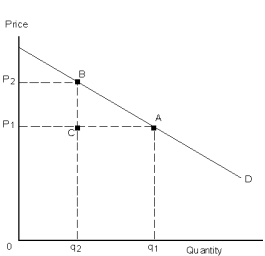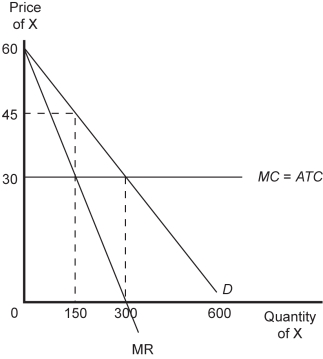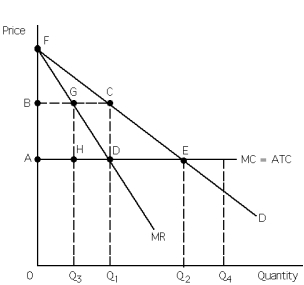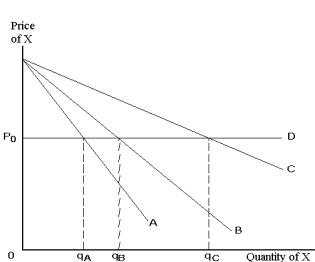A) the competitive firm will attain resource-allocative efficiency, but the monopolist will not.
B) the competitive firm will attain resource-allocative efficiency, but the monopolist may or may not, depending upon the demand for its product.
C) the competitive firm will not attain resource-allocative efficiency, but the monopolist will.
D) both the competitive firm and the monopolist will attain resource-allocative efficiency.
E) neither the competitive firm nor the monopolist will attain resource-allocative efficiency.
G) B) and C)
Correct Answer

verified
Correct Answer
verified
Multiple Choice
Which of the following statements is false?
A) The perfectly competitive firm and the perfectly price-discriminating monopolist both exhibit resource-allocative efficiency.
B) The perfectly competitive firm, unlike the single-price monopolist, exhibits resource-allocative efficiency.
C) The perfectly competitive firm charges the same price for each unit of the good it sells.
D) The perfectly price-discriminating monopolist charges the same price for each unit of the good it sells.
F) A) and C)
Correct Answer

verified
Correct Answer
verified
Multiple Choice
In maximizing profits,a single-price monopolist will charge a price that is
A) less than marginal cost.
B) equal to marginal cost.
C) greater than marginal cost.
D) There is not enough information to answer the question.
F) A) and C)
Correct Answer

verified
Correct Answer
verified
Multiple Choice
The monopoly firm may earn positive economic profits in the long run because
A) it produces a homogeneous product.
B) it is the only firm that wishes to produce the product.
C) of high barriers to entry.
D) a and c
E) all of the above
G) B) and C)
Correct Answer

verified
Correct Answer
verified
True/False
At one time,monopolies were granted to people who were in the favor of kings and queens.
B) False
Correct Answer

verified
Correct Answer
verified
Multiple Choice
Which of the following statements is true?
A) A monopolist can charge whatever price it wants without losing any customers, by virtue of its monopoly position.
B) A monopolist can always increase its profits by increasing its price.
C) In the monopoly market structure, there are low barriers to entry.
D) A monopolist is assured of positive economic profits.
E) none of the above
G) A) and B)
Correct Answer

verified
Correct Answer
verified
Multiple Choice
Which of the following statements is true?
A) For a monopoly firm, its marginal revenue curve and demand curve share two points in common.
B) A monopoly firm is a price taker; it takes the price government sets.
C) A firm that maximizes revenue automatically maximizes profit.
D) Maximizing revenues is the same as maximizing profits only when the firm has no variable costs.
E) a and d
G) None of the above
Correct Answer

verified
Correct Answer
verified
Multiple Choice
Which of the following is not a necessary condition of price discrimination?
A) The seller must be a price searcher.
B) The seller must be able to distinguish between customers willing to pay different prices.
C) It must cost the seller more to service some customers than others.
D) Reselling the product must be extremely costly or must not be possible
F) None of the above
Correct Answer

verified
Correct Answer
verified
Multiple Choice
X-inefficiency results from
A) rent seeking behavior.
B) the lack of competitive pressure.
C) third-degree price discrimination.
D) first-degree price discrimination.
E) none of the above
G) B) and C)
Correct Answer

verified
Correct Answer
verified
Multiple Choice
Exhibit 24-5
 -Refer to Exhibit 24-5.What area represents lost revenue when price goes from P2 to P1?
-Refer to Exhibit 24-5.What area represents lost revenue when price goes from P2 to P1?
A) CBA
B) 0P1Cq2
C) q2CAq1
D) P1P2BC
F) A) and C)
Correct Answer

verified
Correct Answer
verified
Multiple Choice
Exhibit 24-7
 -Refer to Exhibit 24-7.The total revenue collected by a profit-maximizing single-price monopolist is
-Refer to Exhibit 24-7.The total revenue collected by a profit-maximizing single-price monopolist is
A) $4,500.
B) $2,250.
C) $6,750.
D) $9,000.
F) A) and C)
Correct Answer

verified
Correct Answer
verified
Multiple Choice
Exhibit 24-10
 -Refer to Exhibit 24-10.The profit-maximizing single-price monopolist earns total revenue equal to what area?
-Refer to Exhibit 24-10.The profit-maximizing single-price monopolist earns total revenue equal to what area?
A) 0BCQ1
B) 0ADQ1
C) DCE
D) ABCD
E) GFC
G) All of the above
Correct Answer

verified
Correct Answer
verified
Multiple Choice
A single-price monopolist with the same demand and cost conditions as a perfectly price-discriminating monopolist produces __________ output than the perfectly price-discriminating monopolist and __________ resource-allocative efficient.
A) less; is
B) less; is not
C) more; is
D) more; is not
F) A) and B)
Correct Answer

verified
Correct Answer
verified
Multiple Choice
Exhibit 24-6
 -Refer to Exhibit 24-6.Let C be the demand curve facing a perfectly price-discriminating monopolist and P0 the price it charges for the last unit of X it sells.The marginal cost of the last unit
-Refer to Exhibit 24-6.Let C be the demand curve facing a perfectly price-discriminating monopolist and P0 the price it charges for the last unit of X it sells.The marginal cost of the last unit
A) is less than P0.
B) equals P0.
C) is greater than P0.
D) could be any of the above, depending on the shape of the marginal cost curve.
F) All of the above
Correct Answer

verified
Correct Answer
verified
Multiple Choice
"X-inefficiency" refers to
A) the fact that a monopolist wastes resources searching for the price at which it will sell its product.
B) the fact that monopolists don't have to produce at the lowest possible costs in order to survive.
C) the fact that perfectly competitive firms do not earn a profit in the long run and are not a good investment.
D) the difference between what consumers would be willing to pay for additional output from a monopolist and the additional cost of providing that output.
F) None of the above
Correct Answer

verified
Correct Answer
verified
Multiple Choice
Which of the following is an example of a legal barrier to entry?
A) a public franchise
B) a patent
C) exclusive ownership of a scarce resource
D) a and b
E) a, b, and c
G) B) and E)
Correct Answer

verified
Correct Answer
verified
Multiple Choice
Exhibit 24-5
 -Refer to Exhibit 24-5.Suppose a single-price monopolist sells its product at the price P2.Profits are equal to
-Refer to Exhibit 24-5.Suppose a single-price monopolist sells its product at the price P2.Profits are equal to
A) P2 times q2.
B) (P2 - P1) times q2.
C) (P2 - P1) times (q1 - q2) .
D) This cannot be determined without the average total cost curve.
F) C) and D)
Correct Answer

verified
Correct Answer
verified
Multiple Choice
The perfectly competitive firm charges ____________ price for each unit of the good it sells,and the perfectly price-discriminating monopolist charges _________________ price for each unit of the good it sells.
A) the same; the same
B) a different; the same
C) the same; a different
D) a different; a different
F) A) and C)
Correct Answer

verified
Correct Answer
verified
Multiple Choice
Exhibit 24-9
 -Refer to Exhibit 24-9.Assuming that the firm is maximizing profits,the marginal cost of the last unit produced equals
-Refer to Exhibit 24-9.Assuming that the firm is maximizing profits,the marginal cost of the last unit produced equals
A) $4.
B) $40.
C) $5.
D) $50.
E) $6.
G) C) and D)
Correct Answer

verified
Correct Answer
verified
Multiple Choice
Exhibit 24-7
 -Refer to Exhibit 24-7.Let D be the demand curve facing a perfectly price-discriminating monopolist.The marginal revenue it receives from selling the 150th unit of good X sold equals
-Refer to Exhibit 24-7.Let D be the demand curve facing a perfectly price-discriminating monopolist.The marginal revenue it receives from selling the 150th unit of good X sold equals
A) $60.
B) $45.
C) $30.
D) $0, since it sells less than 150 units.
F) A) and B)
Correct Answer

verified
Correct Answer
verified
Showing 41 - 60 of 191
Related Exams